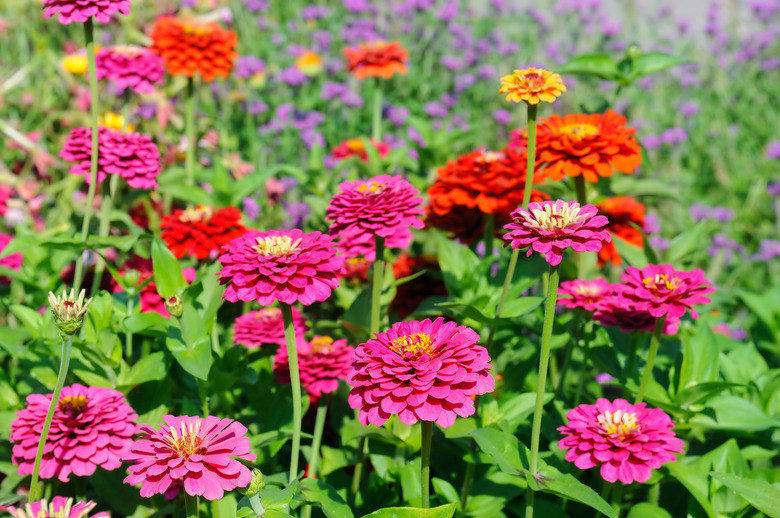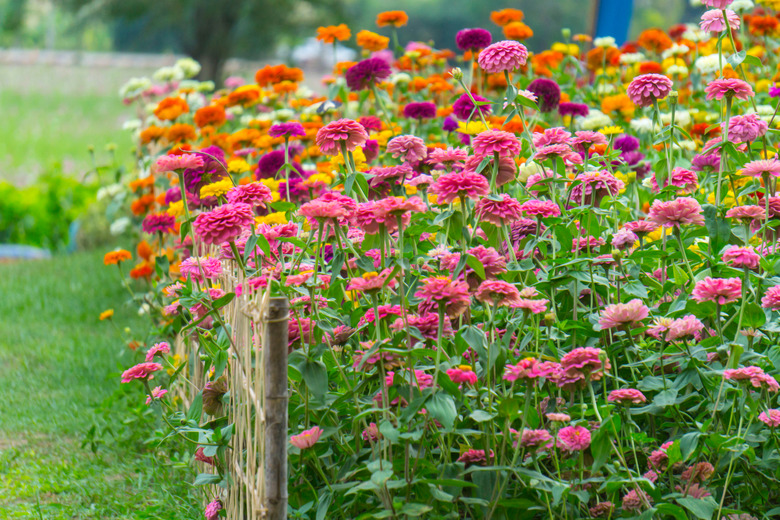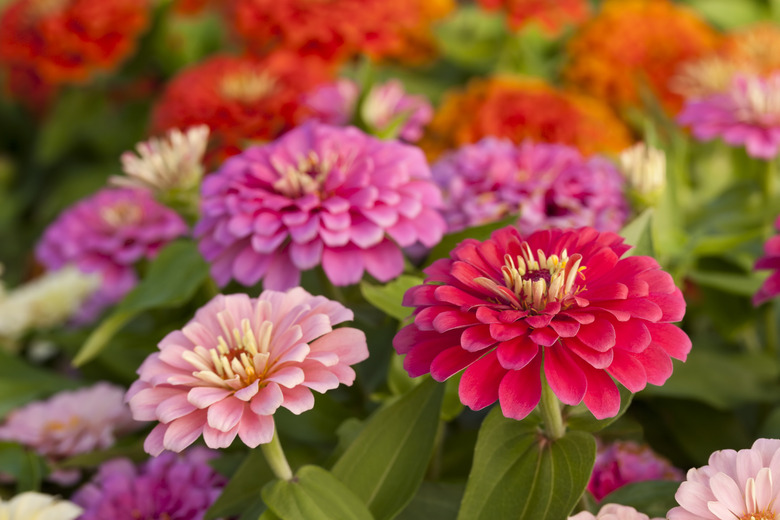How To Grow Zinnias
We may receive a commission on purchases made from links.
Zinnias (Zinnia spp.) are among the easiest annuals a gardener could plant. These fast-growing flowers come in a vast range of colors and light up your garden beds in summer and fall. One bright blossom appears on each stem about two months after planting.
Best Uses for Zinnias
Best Uses for Zinnias
Gardeners wanting pops of bright color in the annual garden plant zinnias in the spring. Few bedding flowers produce as many blooms as quickly and easily as zinnias do. You can seed borders or edging areas with smaller, more compact varieties, and these also work well in containers or window boxes. Bigger plants can grow several feet tall and serve well in cottage gardens or cutting gardens. They are best placed in the background of garden beds with shorter plants in front.
Zinnia flowers come in brilliant shades of orange, red, pink, blue, purple, and yellow along with white. In fact, it's fair to say that you can find zinnias in almost every color of the rainbow. Many gardeners opt for a multicolor pack of zinnia seeds to make things even brighter.
You can also select from three types of zinnia flowers according to the effect you desire. Cultivars with single zinnia flowers resemble daisies, with a single row of petals and a center that is always visible. Double zinnia flowers have many rows of petals — so many that they look more like mums than daisies, appearing in pompoms of color without any visible centers. If you are looking for middle ground, go for semi-double zinnias, which have multiple rows of petals but visible centers.
There are still more choices. Besides height and flower type, you can choose the shapes for your blossoms. Look for beehives, buttons and cactus shapes among others. Whatever you choose is sure to require little maintenance and provide a lush swath of color. Since zinnias are annuals, one season is all you can expect from their flowers, but with a little luck, your plants may toss out seeds that grow again the next summer.
How to Start Zinnias From Seed
How to Start Zinnias From Seed
Zinnias are tough plants when it comes to drought and soil tolerance, but they don't take well to transplanting. Your best bet is to grow zinnias from seeds sown directly in the garden beds. The plants emerge quickly and will flower no later than 60 days after the seeds hit soil. Some gardeners like to sow seeds on consecutive weeks to extend the bloom time.
Pick a sunny location that offers well-draining soil with a pH between 5.5 and 7.5. While zinnias are meadow plants that are not picky about soil, you'll see flowers quicker if you loosen the soil well before planting.
Sow the seeds about 1/4 inch below the soil surface, and you'll likely see seedlings within a week. When they approach 3 inches tall, it's time to thin them out. It's important to leave space between the plants for good air circulation since dense planting promotes fungal disease. Exactly how much space depends on the specifics of the zinnias, with larger plants requiring more elbow room. Generally, they require between 6 and 18 inches, but check the seed packet for specifications.
In What Zone Do Zinnias Grow Best?
In What Zone Do Zinnias Grow Best?
Zinnias can be grown successfully in most hardiness zones, including U.S. Department of Agriculture plant hardiness zones 2 through 11. Zinnias are annuals that die with the first hard frost. Unlike perennials, the same plants do not reappear the following season. Instead, they germinate, bloom, and die in one growing period.
When Should You Plant Zinnias?
When Should You Plant Zinnias?
The general rule is to plant zinnias after the last frost of spring, but you might want to wait a bit longer. Zinnias grow best when the minimum daytime temperatures are between 74 and 84 degrees Fahrenheit and the soil has lost its winter chill.
Soil, Sunlight, and Water Recommendations for Zinnias
Soil, Sunlight, and Water Recommendations for Zinnias
Zinnias are tough prairie plants. Although they grow fastest and best in well-draining, organically rich soil, they are not among the picky plants of the garden. They can even grow in clay or other poor soils. If you want to maximize blooms and minimize the wait for blooms, work organic matter such as compost into the garden bed before planting. Zinnias do better with a slow-release fertilizer mixed into their planting soil. This is especially true for zinnias planted in containers in soilless potting mix.
Zinnias need full sun exposure to perform their best. Direct sunlight is the most essential element for zinnia beds. It not only gives the plants the rays they require, but it helps keep the foliage dry to ward off the fungal diseases to which they are prone. The only reason you may want to plant zinnias in dappled sunshine areas is if your summer temperatures rise well above 100 degrees.
Zinnias are remarkably drought-tolerant plants, and they can survive with little irrigation, but that doesn't mean they don't like the occasional drink. The best advice is to keep the soil moderately moist but avoid overwatering.
How to Propagate Zinnias
How to Propagate Zinnias
If you don't deadhead your zinnia plants in late fall, some of them may disburse their seeds and regrow new plants the next spring. This is called self-seeding, and encouraging it can save you money.
In fact, you can collect and save the zinnia seeds for sowing the following year by harvesting the dried blossoms from the plants in autumn. It's important to note, however, that hybrid cultivars likely won't produce seeds that result in plants with similar flowers, and they may not germinate at all. Grow heirloom zinnias to be assured of plants that produce viable seeds.
To harvest and save seeds, clip off the spent flowers that have dried and turned brown (the seeds from fresh flowers have not matured yet) and remove the small, arrowhead-shaped seeds from between the zinnia petals. Store them in a paper envelope and then put the envelope in a sealed glass jar in the refrigerator with a packet of silica gel desiccant to absorb moisture.
Common Pests and Other Problems for Zinnias
Common Pests and Other Problems for Zinnias
Deer can destroy all leaves or large sections of leaves and flowers on your zinnia plants, leaving ragged bits. Some garden websites say that these plants are deer-resistant, but don't take that as gospel. If the leaves and flowers disappear overnight and the stems remain, look around on the ground for hoof prints or scat. To prevent deer from chomping down your zinnias, you'll need to install a tall fence.
Wild or domestic rabbits can also eat zinnia leaves, and like with deer, the damage occurs suddenly, often overnight. Deer scat is different from rabbit droppings, so look for paw prints and scat to identify the pest. In addition, when rabbits attack zinnia plants, they cut off the stems at a clean 45-degree angle. Scattering blood meal around the plants is said to repel the bunnies.
Aphids are sap-sucking insects so small that you aren't likely to notice them unless there is an infestation. These soft-bodied pests suck the plant juices from zinnias through holes they bore into the leaves and stems. Look for aphids on the underside of the leaves or on the stems just below the buds. Try washing them off with a powerful hose stream.
Armyworms are fairly hefty caterpillar pests that are the larval stage of armyworm moths. They are often black with yellow stripes and like to eat the leaves and petals of zinnia plants. While they are not beneficial for the zinnias, they are excellent food to attract birds to your garden. Pick them off the plants in the morning and toss them on the ground for the birds to consume.
Mealybugs are another small bug (1/8 inch long) that can cause big problems. They look like tiny cotton balls with legs, but they damage zinnias by feeding and also by introducing diseases into the garden. Like aphids, they have piercing/sucking mouthparts that allow them to suck the juices from zinnia leaves. They excrete a compound called honeydew that encourages the growth of sooty mold and plant viruses. Blast the bugs off with the hose or spray them with neem oil.
Spider mites are even smaller than mealybugs at only 1/50 inch long, and they are members of the spider family. They damage plants in the same way as mealybugs and aphids by sucking the sap from zinnia leaves. You'll probably notice the spiderlike webbing before you see the bugs themselves. You may also see stippling on the leaves that makes them look bronzed with a yellowed discoloration. Try clearing them with a hose blast, and if that doesn't work, bring out the neem oil spray.
Slugs damage zinnia leaves during spring and summer, leaving ragged holes across the veins of the foliage. Because they primarily chow down at night, you'll probably see the damage without seeing the slugs themselves. The way to deal with slugs is to scout for them in the evening or very early morning and pick them off by hand before disposing of them.
Japanese beetles are the insect pest to blame when you find zinnia leaves skeletonized with only the veins remaining. Look around the plant for metallic green beetles with copper-colored wings. These beetles also chew holes in your pretty zinnia flowers. This is another instance when neem oil spray can help.
European earwigs bore tiny holes into both the foliage and blossoms of your zinnias, usually doing the damage at night. They are easy-to-recognize insects with their long, mahogany-colored bodies and short, sharp forceps. You can trap them by putting shallow bowls of vegetable oil under the plants, and you can then kill them with insecticidal soap.
Common Diseases for Zinnias
Common Diseases for Zinnias
Zinnias are susceptible to a variety of fungal diseases. These include fungal leaf spot, powdery mildew (which looks like someone sprinkled flour over your plants), and blight. All are easier to prevent than to cure, and you may want to purchase disease-resistant zinnias to get ahead of this problem. Moisture remaining on foliage is one of the main reasons zinnias get fungal diseases.
Your zinnias are much less likely to come down with these diseases if you plant them in a spot with lots of direct sun and space them appropriately. Look at the spacing listed on the seed packets and add a few inches if you've had fungal issues in the past. You want drying wind to pass between and through the plants.
In addition, water these annuals at the base of plants, not from overhead. Don't overwater and when you do irrigate, do so in the morning since a full day of sun is usually enough to dry off moisture before nightfall. Remove dead leaves and any other plant debris from the base of the plants and keep the beds clean.


